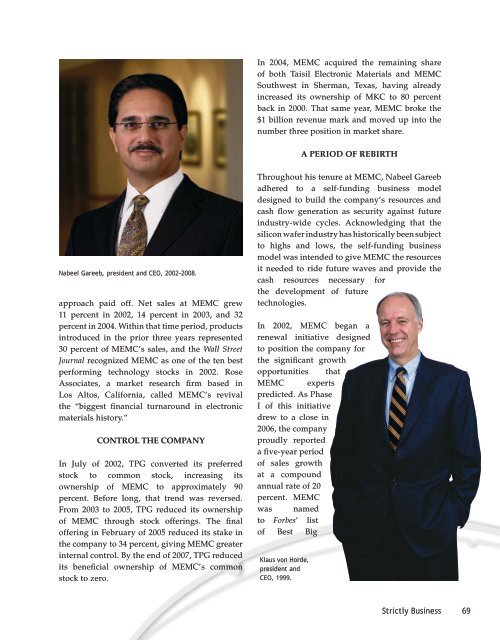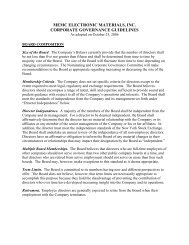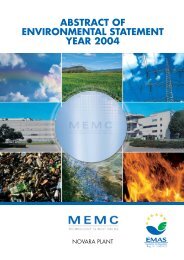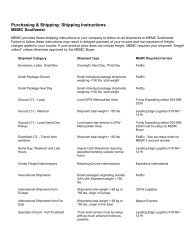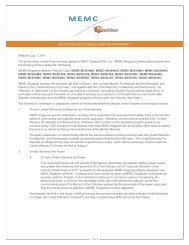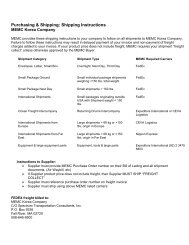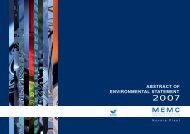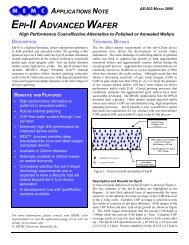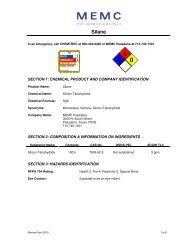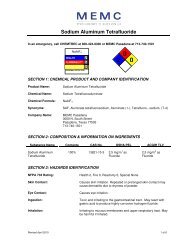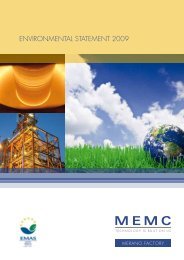BUILDING ON THE PAST, READY FOR THE FUTURE: - MEMC
BUILDING ON THE PAST, READY FOR THE FUTURE: - MEMC
BUILDING ON THE PAST, READY FOR THE FUTURE: - MEMC
Create successful ePaper yourself
Turn your PDF publications into a flip-book with our unique Google optimized e-Paper software.
Nabeel Gareeb, president and CEO, 2002–2008.<br />
approach paid off. Net sales at <strong>MEMC</strong> grew<br />
11 percent in 2002, 14 percent in 2003, and 32<br />
percent in 2004. Within that time period, products<br />
introduced in the prior three years represented<br />
30 percent of <strong>MEMC</strong>’s sales, and the Wall Street<br />
Journal recognized <strong>MEMC</strong> as one of the ten best<br />
performing technology stocks in 2002. Rose<br />
Associates, a market research firm based in<br />
Los Altos, California, called <strong>MEMC</strong>’s revival<br />
the “biggest financial turnaround in electronic<br />
materials history.”<br />
Control the CoMPany<br />
In July of 2002, TPG converted its preferred<br />
stock to common stock, increasing its<br />
ownership of <strong>MEMC</strong> to approximately 90<br />
percent. Before long, that trend was reversed.<br />
From 2003 to 2005, TPG reduced its ownership<br />
of <strong>MEMC</strong> through stock offerings. The final<br />
offering in February of 2005 reduced its stake in<br />
the company to 34 percent, giving <strong>MEMC</strong> greater<br />
internal control. By the end of 2007, TPG reduced<br />
its beneficial ownership of <strong>MEMC</strong>’s common<br />
stock to zero.<br />
In 2004, <strong>MEMC</strong> acquired the remaining share<br />
of both Taisil Electronic Materials and <strong>MEMC</strong><br />
Southwest in Sherman, Texas, having already<br />
increased its ownership of MKC to 80 percent<br />
back in 2000. That same year, <strong>MEMC</strong> broke the<br />
$1 billion revenue mark and moved up into the<br />
number three position in market share.<br />
a PerIod oF reBIrth<br />
Throughout his tenure at <strong>MEMC</strong>, Nabeel Gareeb<br />
adhered to a self-funding business model<br />
designed to build the company’s resources and<br />
cash flow generation as security against future<br />
industry-wide cycles. Acknowledging that the<br />
silicon wafer industry has historically been subject<br />
to highs and lows, the self-funding business<br />
model was intended to give <strong>MEMC</strong> the resources<br />
it needed to ride future waves and provide the<br />
cash resources necessary for<br />
the development of future<br />
technologies.<br />
In 2002, <strong>MEMC</strong> began a<br />
renewal initiative designed<br />
to position the company for<br />
the significant growth<br />
opportunities that<br />
<strong>MEMC</strong> experts<br />
predicted. As Phase<br />
I of this initiative<br />
drew to a close in<br />
2006, the company<br />
proudly reported<br />
a five-year period<br />
of sales growth<br />
at a compound<br />
annual rate of 20<br />
percent. <strong>MEMC</strong><br />
was named<br />
to Forbes’ list<br />
of Best Big<br />
Klaus von Horde,<br />
president and<br />
CEO, 1999.<br />
Strictly Business 69


